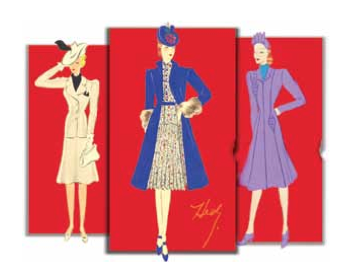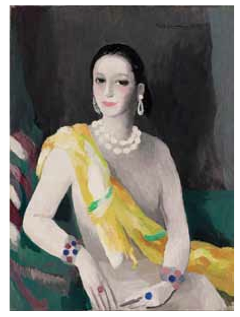
by admin
Happening
Stitching History from the Holocaust
In the winter of 1939, Paul Strnad wrote his cousin Alvin in Milwaukee. Desperate to obtain an affidavit to escape from Nazi Germany, Paul sent Alvin sketches by his talented dress-designer wife, Hedwig Strnad, hoping examples of her work would prove their financial independence. Despite Alvin’s best efforts, both Hedwig and her husband Paul were murdered in the Holocaust. All that remained of their story were the letter and Hedwig’s drawings. The Jewish Museum of Milwaukee worked with the costume shop of the Milwaukee Repertory Theater creating the dresses Hedwig sketched to tell the Strnad family story. A video tells how the unusual exhibition came to be. Through February 28 in Milwaukee, then available for travel. stitchinghistory.org.

Fierce and Brave Females
Artist-activist Linda Stein, perhaps best know for her Wonder Woman paintings focusing on imaginary female heroes, is now focusing on real ones. For her new project she has produced tapestries of 10 women of particular bravery during the Holocaust: Anne Frank for her courage under duress and representing the loss of 1.5 million Jewish children. Ruth Gruber, the 104-year-old journalist who rode the ship Exodus and helped Holocaust survivor refugees. Vitka Kempner, a leader of the only known undefeated ghetto uprising. Noor Inayat Khan, the first female radio operator sent from Britain to aid the French resistance. Zivia Lubetkin, an underground leader in Nazi-occupied Warsaw. Nadezhda Popova, a military pilot in the Soviet Union. Hadassah Bimko Rosensaft, who worked in the Jewish infirmary at Auschwitz, and after liberation helped rehabilitate thousands of Jewish survivors. Hannah Senesh, who assisted in the rescue of Hungarian Jews. Yukiko Sugihara who encouraged her husband, Japan’s consul in Kovno, Lithuania, to issue visas, saving 6,000 Jews. And Nancy Wake in the French Resistance, one of the Allies’ most decorated wartime servicewomen. The project includes tapestries in leather, metal, canvas, paint, fabric, and mixed media, an illustrated catalogue with essays, limited-edition fine-art prints, a video about the artist’s process, a teaching guide and public programs. lindastein.com.
A Tribute to the Disappeared
Artists and writers are invited by New York City-based visual artist Andrea Arroyo to participate in creating an “online quilt”—like the AIDS Memorial Quilt, only virtual —that will focus on another epidemic: the loss of lives to political “disappearances,” from the 43 students in Ayotzinapa, Mexico, and the women of Juarez to all of the disappeared the world over. Jewish women in particular were among the disappeared in Argentina’s Dirty War 1976–1983. To send literary and artistic contributions for the quilt project: facebook.com/tributetothedisappeared.
Jews, Arabs and Art
The Arab Museum of Contemporary Art and Heritage (AMOCAH) in the Galilee, opening in December, will showcase original works of contemporary art alongside items of Palestinian heritage, and will host artistic cooperation and collaboration between Jews and Arabs. “This museum is an opportunity for Jews and Arabs to meet, for their cultures to meet,” says Israeli artist Avital Bar-Shay, one of the founders. The museum, located in Sakhnin’s Old City, has more than 2,000 objects related to Palestinian Arab heritage and some 200 contemporary artworks. An artist-in-residence program is in the works. Following Operation Protective Edge last summer, the museum’s launch was stepped up, in order to reduce the tensions between Jews and Arabs. The opening exhibit is “Hiwar,” the Arabic word for “dialogue.”
The Fez as Storyteller
Artist Camille Eskel’s newest work explores the Baghdadi-Jewish experience in India that formed her family history and psychological legacy. Both grandfathers manufactured or traded fez caps, and the artist’s hats carry information about identity, cultural influence, gender relationships, and intergenerational beliefs, practices and attitudes. The Hebrew words on this fez quote from the archaic morning prayer recited by men giving thanks that “I was not created a woman.” The backdrop is a section of the Bombay synagogue Eskel’s mother’s family attended, and the women portrayed are from her family. camilleeskell.com/gallery/the-fez-as-storyteller.
Religous Women Dancing
Nehara, an Israeli dance troupe for professional female dancers who happen to be religious, aims to combine traditional values — such as not performing on Shabbat and being a women-only performance group — with dancing at its highest level. “Dance and religion do not mesh easily. On the contrary — they clash in almost every way possible. Yet, ever since I can remember, I have juggled my way between these two opposite worlds,” says Daniella Bloch, founder and artistic director. Revolutionary within the dance world and within the Orthodox Jewish world, their performances are open to all audiences, Orthodox and secular, men and women. neharadance.org.

Wartime Lullabies
“Birth in a Time of Bloodshed” is a CD anthology of lullabies from 18 conflict zones, sung in their original languages. The songs were collected by Israeli musician and storyteller Hanna Yaffe, whose goal is to emphasize the universality of lullabies and our shared humanity. The lullabies contain stark contrasts, with the melodies communicating sweetness and love, while the words relate fear, uncertainty and darkness. lullabies-of-loss.org/#!lullabies/c1h6a.
Judaism & Islam in America
Sharing the Well: A Resource Guide for Jewish-Muslim Engagement features common themes such as caring for others, prayer and life cycle events, plus guidelines for dialogue. A joint project of Jewish Theological Seminary, Hartford Seminary and the Islamic Society of North America, it is the fruit of almost five years of academic workshops and community-based pilot projects. Contributors include Kim Zeitman, Karen Nell Smith, Joyce Schriebman, Sarah Sayeed, Suumaya Khalifa, Rabbi Jill Jacobs, Maggie Siddiqu, Rabbi Nina Beth Cardin, Rabbi Amy Eilberg, Rabbi Ita Paskind, Rabbi Rachel Kahn-Troster and Rabbi Julie Schonfeld. Available as a hard copy and online as a free PDF. isna.net/uploads/1/5/7/4/15744382/sharing_the_well_final.pdf.
Helena Rubinstein
“Beauty Is Power” is the first museum exhibition to focus exclusively on this cosmetics entrepreneur and patron of the arts, born in 1872 in a small town in Jewish Poland. By her death at 92, in 1965, Rubinstein was in her seventh decade of business, producing and marketing the means for ordinary women to transform themselves, and challenging the myth of beauty and taste as inborn, or something to which only the wealthy were entitled. If latter-day feminist debates have focused on cosmetics as objectifying women, they were seen in the early twentieth century as a means of asserting female autonomy, contributing to women’s empowerment, and advocating exceptionality in a world that discouraged nonconformity. One’s identity, Rubinstein asserted, is a matter of choice. At the Jewish Museum in New York through March 22. thejewishmuseum.org

Free the Nipple
A group of fearless women fight for their right to go topless in public, as they smash societal taboos one bare breast at a time. Based on a true story, this spirited satire follows New York City activists Liv and With, who take their crusade for gender equality from the streets of the urban jungle to the courts. More than just a movie, Free the Nipple has launched an empowering real-life movement, inspiring women across the globe to take back their bodies. freethenipple.com
Dreaming in Yiddish
The Adrienne Cooper Dreaming in Yiddish Fund was established in memory of the beloved pioneering teacher, researcher and performer of Yiddish music. (Cooper wrote about stories of intimate violence in Yiddish songs by women in Lilith, Spring 2011.) Now, with the support of her brother Michael Cooper, the Adrienne Cooper Archives will be housed at the YIVO Institute for Jewish Research. The fund also sponsors the annual Adrienne Cooper Dreaming In Yiddish Award Concert which supports risk-taking artists who are making art in, with and around Yiddish. gohproductions.org or email marshagildin@gmail.com or call (212) 740-9644.
Compiled by Naomi Danis. For more, follow Lilith on Facebook and Twitter, and check out Lilith.org, where you can sign up for Lilith’s free email newsletter. Send ideas for this section to info@Lilith.org.